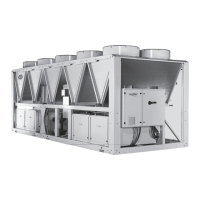2142GW
See g. 15.
• A device of this kind is not publicly accessible. It must be installed
at least 2.5 m above ground level.
• If possible, install the unit in the centre of the room. The air flow
direction may be adjusted manually by moving the deflector fins
depending on the operating mode (cooling or heating); this helps
to optimise the distribution of air in the room.
• During cooling mode operation the best position for the deflecting
louvres is one which allows air diffusion close to the ceiling
(Coanda effect). In heating mode, the louvres should be positioned
so that the air is directed towards the floor, in order to prevent
layers of hot air forming in the upper part of the room.
• In order to allow easy and rapid installation and maintenance,
make sure that in the selected position it is possible to remove
the ceiling panels or, if the ceiling is constructed of masonry, that
access to the unit is guaranteed.
ATTENTION:
Only restrict the air outlets as indicated in the drawing g.15
For units equipped with electric heaters the use of the"AIR
SUPPLY OBSTRUCTION" kit is NOT allowed.
Prior to installation
It is advisable to place the unit as close as possible to the installation
site before removing it from the packaging. The grille panel and the
control are separately packed for maximum protection (See g. 16).
IMPORTANT:
Do not lift the unit by the condensate drain discharge pipe;
hold it by its four corners only.
Unit installation will be facilitated using a stacker (See g. 16).
If plaster board ceiling panels are installed the maximum dimensions
of the unit housing must not exceed 660 x 660 mm (mod. 200-300-
400) and 900 x 900 mm (mod. 500-600-701).
For rooms with high humidity, insulate the suspension anges.
Installation
Mark the position of the suspension rods, the heat-transfer medium
duct and the condensate drain pipe, the electrical wires and the
remote control cable (see dimensions). The cardboard template
(supplied with the kit) may be of assistance for this operation.
Depending on the type of ceiling the hangers can be xed as shown
in the drawing 17.
Once the threaded hangers have been positioned, do not tighten
the nuts, and insert the washers as shown in the drawing 18.
First position the connection lines, as described in the chapter
"Water connections". Remove the "T" bar in order to facilitate
installation operations (See g. 19).
Carefully lift the unit (without the frame) using the four suspension
brackets (or the four corners), inserting it into the false ceiling.
If the "T" bar cannot be removed the unit may need to be tilted (this
operation may only be carried out with false ceilings with a minimum
height of 300 mm) (See g. 20).
Position the unit horizontally using a spirit level by adjusting the nuts
and lock nuts on the threaded tie-rods and maintaining a distance
of 25-30 m between the sheet metal body and the lower surface of
the suspended ceiling.
Reposition the "T" bar and align the unit in relation to the bar by
tightening the nuts and locknuts. After the condensate drain pipe
and the water ducts have been connected check, check to make
sure that the unit is level (See g. 21).
Condensate drain
See g. 22 - 23.
• Use a siphon at least 50 mm deep to prevent unpleasant odours
from circulating in the room.
• Condensate may be discharged at a maximum height of 200
mm above the unit, as long as the ascending tube is vertical and
aligned with the drainage flange.
• To drain the water from a level higher than 200 mm, install an
auxiliary drain pump with a condensate drain pan and a level
controller.
• . A float valve is recommended to stop the flow switch if there is a
fault at the auxiliary pump.
• The condensate drain pipe must be covered with insulating
material to prevent the risk of condensation.
• If more than one unit is installed in the room, the drain system can
be made as shown in the drawing fig.23.
lnstallation

